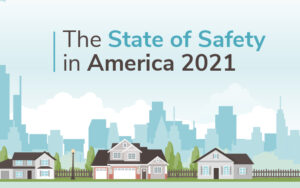The State of Safety in America 2021
Over three years, we talked to more than 15,000 Americans to see how safe they feel living in the US. Find out which states worry the most about safety, which ones worry least, and where people have experienced the most run-ins with violent and property crime.
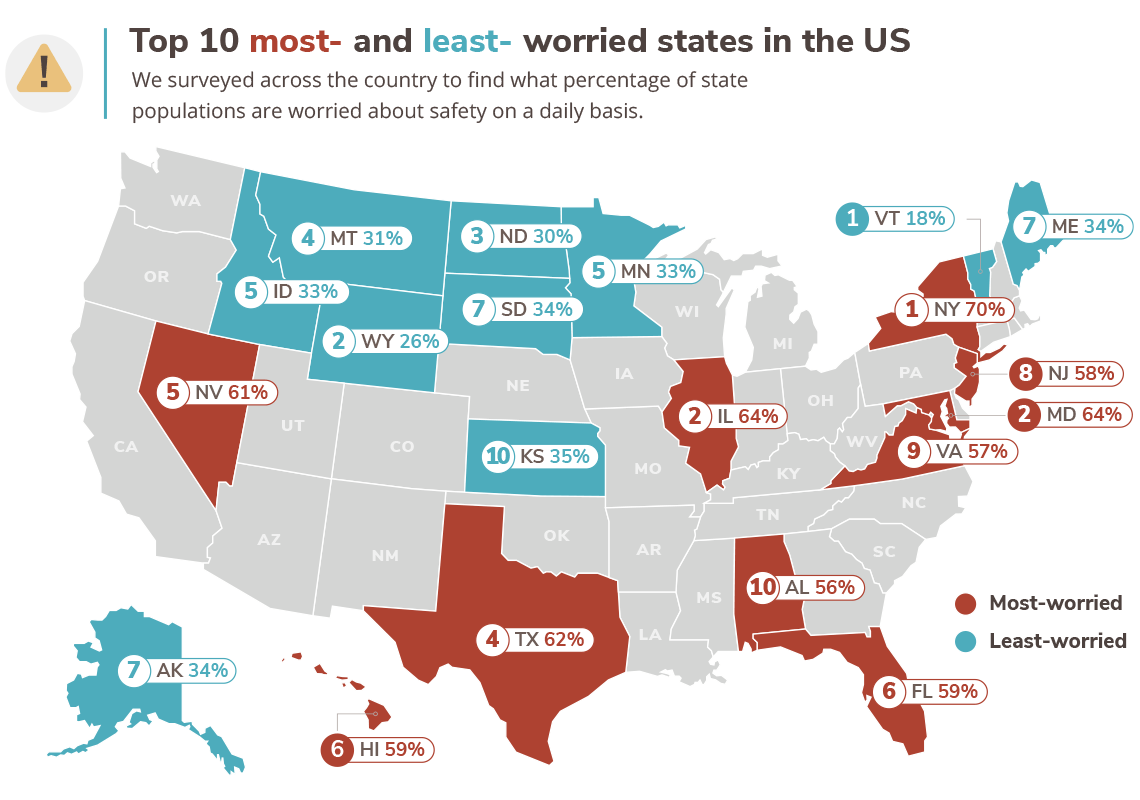
What is the State of Safety survey?
The State of Safety is a nationwide survey that dives into America’s top safety concerns. Over the past three years, we’ve surveyed more than 15,000 Americans—at least 300 from every state—to find out about their perceptions and attitudes about safety and crime.
We use this data to spot trends in how people perceive safety and danger, as well as respondents’ experiences with different types of crimes. We also compare perceptions of safety and danger with the reality of crime statistics in our Safest Cities reports.
Based on participants’ answers and data trends, we’ve adapted the survey each year to respond to current events and areas of growing concern.
- In 2020, we added questions about mass shootings.
- In 2020, we also narrowed our focus to the most impactful and measurable issues: property and violent crime.
- We expanded our questions to address gun violence as a whole this year, not just mass shootings.
This year, we also added questions about package theft, police violence, and the COVID-19 pandemic.
Find out more about the State of Safety study on our methodology page.
In light of recent headlines, we released a report on how concerned Americans are about gun violence.
States where people feel the most and least safe
On top of asking people how much they worry about safety every day, we wanted to find out if people feel safe in their state.
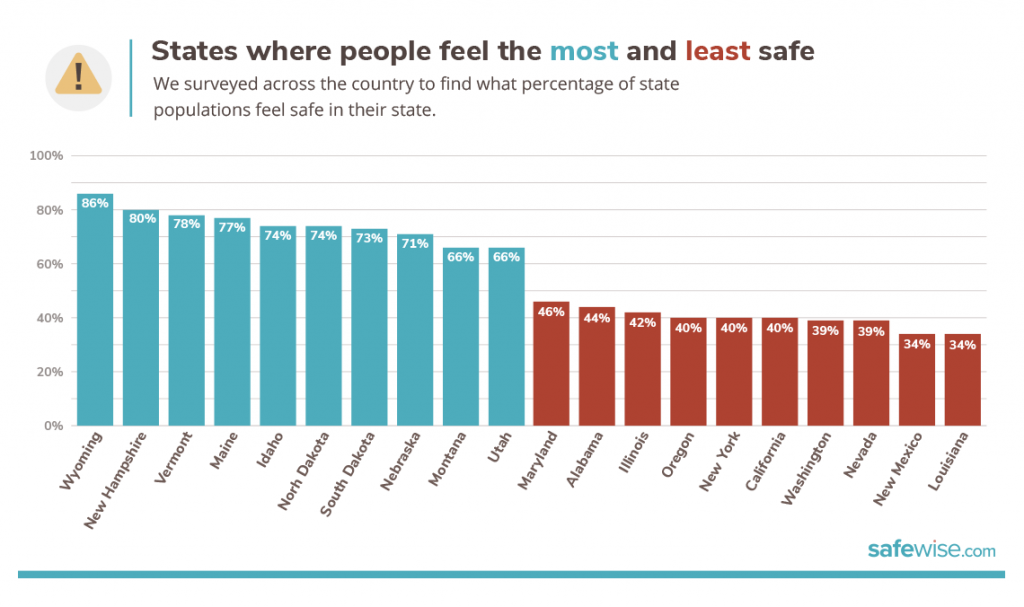
A closer look at how Americans feel about crime and safety
We were surprised to see an 8% drop in the overall level of daily concern about safety over the past three years—even though nearly 7 in 10 Americans think crime is increasing.
With the global pandemic and widespread civil unrest across the country in 2020, we expected to see general concern on the rise, but it rose by only one percentage point year over year.
- Fewer than 1 in 10 Americans think crime is decreasing although it’s been on a downward trend for the past 2 decades.
- New York is by far the most concerned state, while Vermont, Wyoming, and North Dakota are typically the least concerned states.
- Package theft is the most worrisome crime issue for Americans, with nearly 5 in 10 respondents worried that it will happen to them.
- Property crime is the second-most worrisome crime issue, with 4 in 10 Americans worried that it will happen to them.
- Even though more than half of all Americans are concerned about gun violence daily, only 38% are worried that it will happen to them.
- Although the national average for daily concern increased by only 1 point year over year, half of the most-worried states saw concern rise by 10% or more between 2019 and 2021.
- Women, younger Americans, and those with kids at home express higher levels of crime concern than other demographic groups.
- Americans aged 55 or older have strikingly fewer personal experiences with all types of crime compared to every other demographic factor.
How safety concerns have changed over the past 3 years
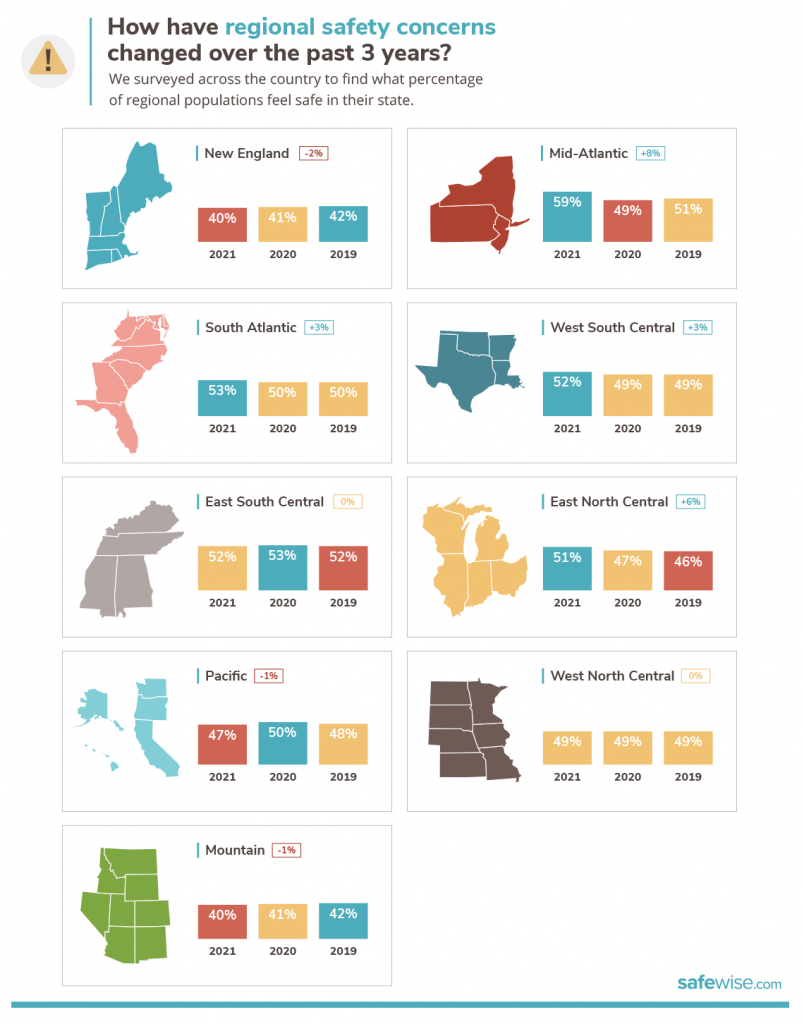
Regional concern trends
- The Mid-Atlantic region had the highest level of daily concern of any region—59% this year. It also had the biggest jump in concern, rising 8% since 2019 (the same as the US average).
- The West North Central region had the lowest level of daily concern of any region—39% for each of the past 3 years.
- Over the past 3 years, levels of concern didn’t fluctuate more than 8% in any region.
- Two regions remained steady in concern over time: East South Central and West North Central.
- Regions in the southern US generally have higher levels of concern about crime and safety
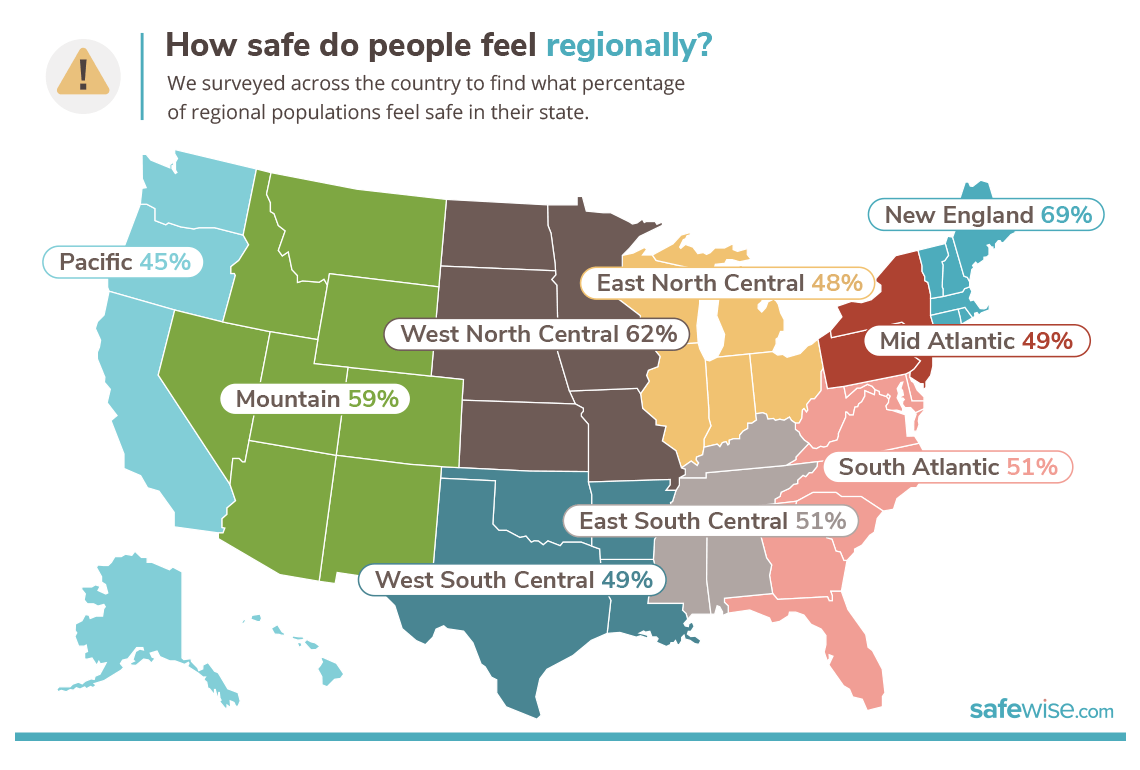
Most-concerned state trends
- Among the most-concerned states, safety concern fluctuations ranged from 5% to 16% with the exception of Alabama, where concern stayed steady over time.
- Among the most-concerned states, half of the group surpassed the US average safety concern fluctuation of 8% over 3 years.
- Virginia saw the biggest swing in concern levels year over year, dropping 23% between 2019 and 2020, and jumping 43% between 2020 and 2021.

Least-concerned state trends
- Among the least-concerned states, levels of concern fluctuated broadly, ranging from a 14% drop in Kansas to a 5% increase in Alaska.
- More than half of the least-concerned states fell under the US average percentage of fluctuation.
- Vermont’s low level of daily concern about safety is 62% below the national average. Vermont has the fourth-lowest violent crime rate in the country, and the eighth-lowest property crime rate.
Violent crime: Fear vs. reality
Despite the traumatic fallout of violent crimes, Americans are less worried about a violent crime actually happening to them. Americans also experience far fewer violent crimes than they do property crimes. In 2019, violent crimes made up 15% of all reported crime in the US.
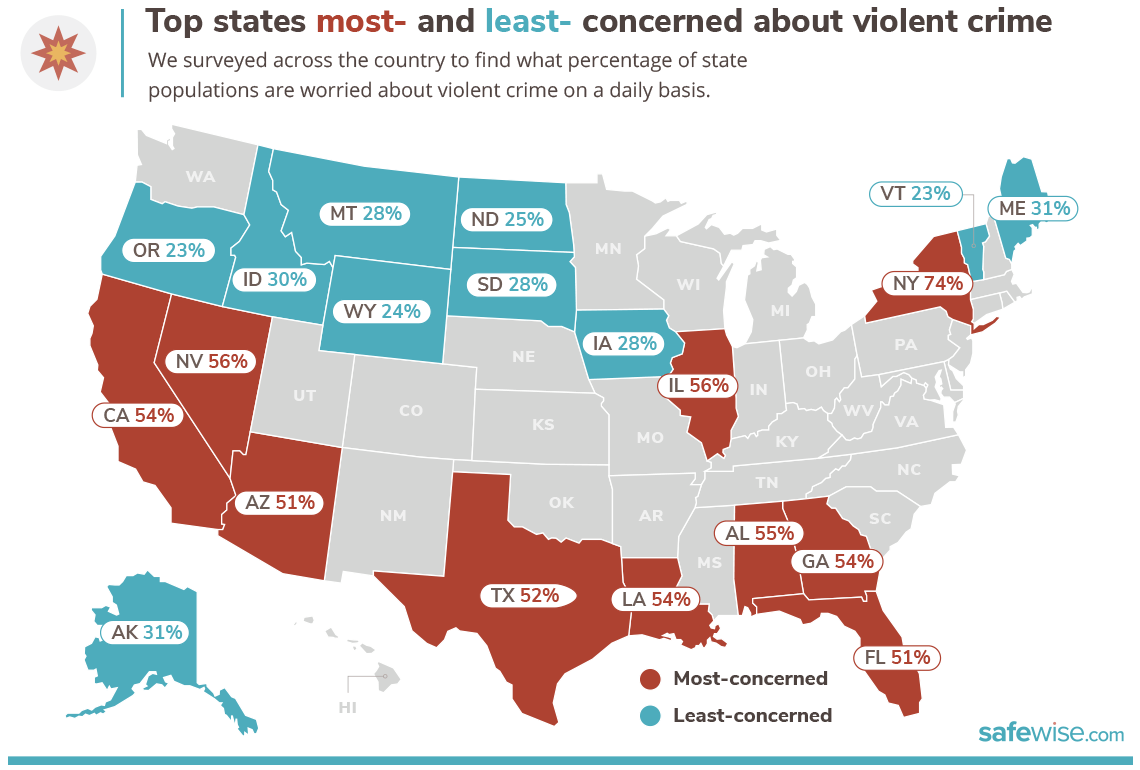
Violent crime rose by 1.9% year over year in Louisiana, while property crime fell by 3.7%.
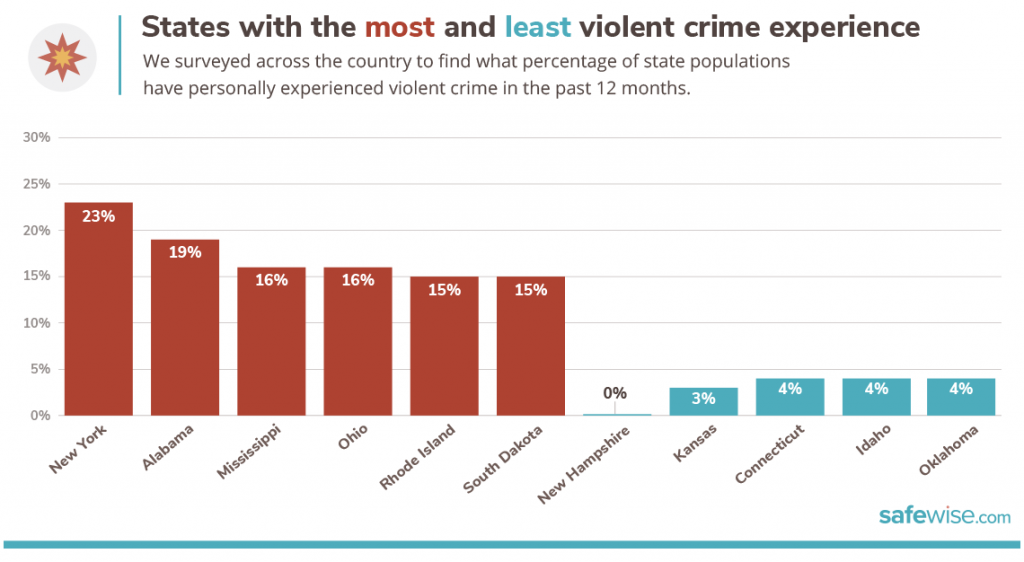
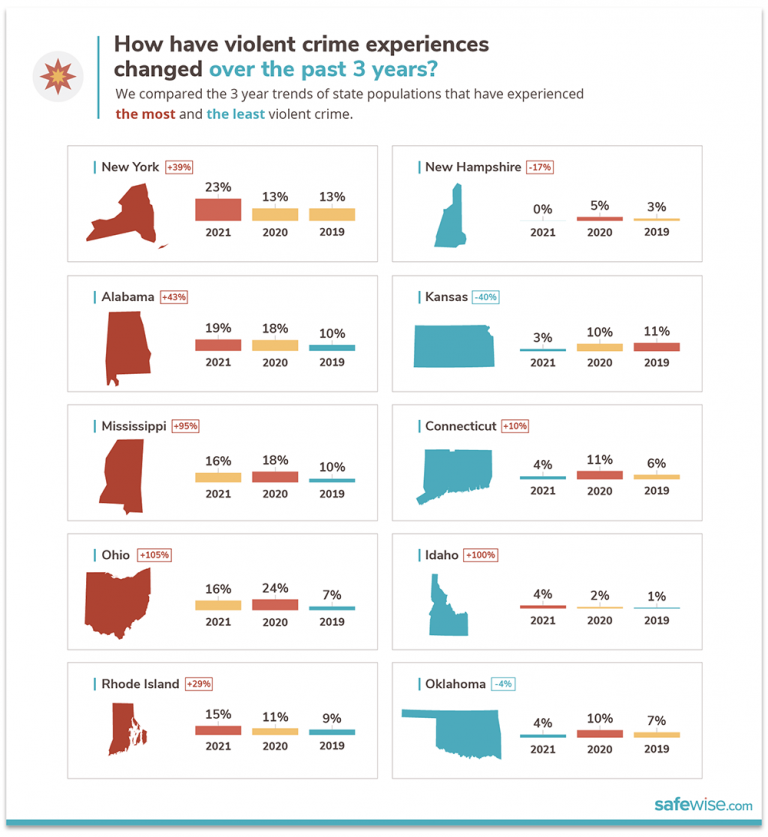
Gun violence
After an overwhelming number of respondents from our 2019 survey expressed concern about mass shootings, we added that category to the State of Safety survey in 2020. Last year, we received another avalanche of answers indicating concern over gun violence in general.
For the 2021 State of Safety survey, we asked Americans about their concerns and experience with gun violence.
Mass shootings in AZ decreased by 33% year over year.
States with the most and least gun violence experience (US average 10%)
Interesting findings
- For the first time, respondents mentioned hearing gunshots where they live—from Alaska to Connecticut.
- Despite stay-at-home orders, mass shootings jumped 47% year over year.
- Mention of riots and protests came up in at least 460 answers to the question, “what keeps you up at night?”. Gun-related terms came up over 130 times.
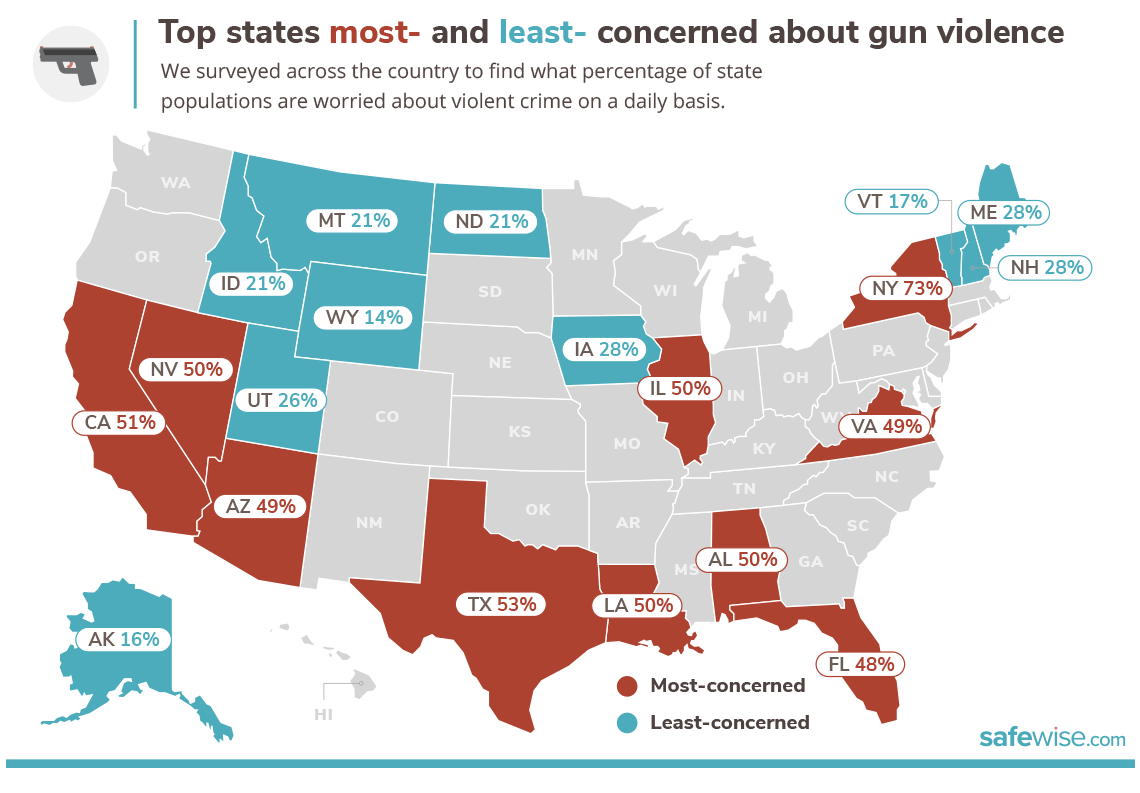
Property crime: Fear vs. reality
For the third consecutive year, property crime is still the crime Americans feel is most likely to happen to them, and they’re not wrong. In 2019, a property crime happened every 4.6 seconds in the US. But the property crime rate fell 4% year over year—and dipped below seven million total crimes for the first time in at least 20 years.
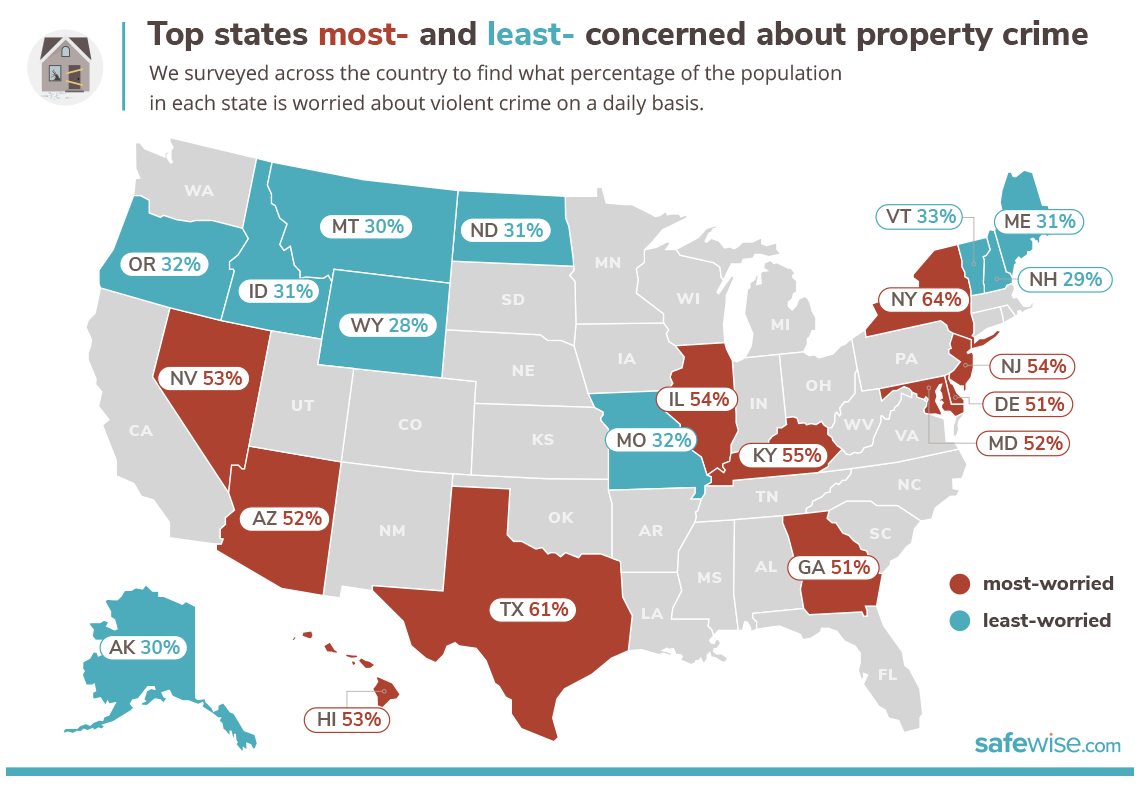
Oklahoma’s property crime rate decreased by 0.7% year over year.
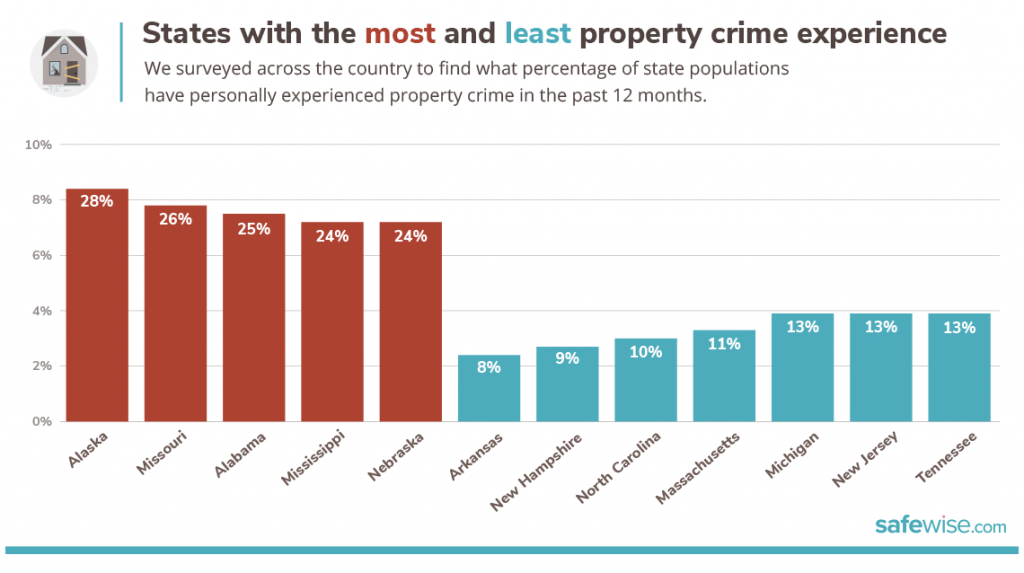
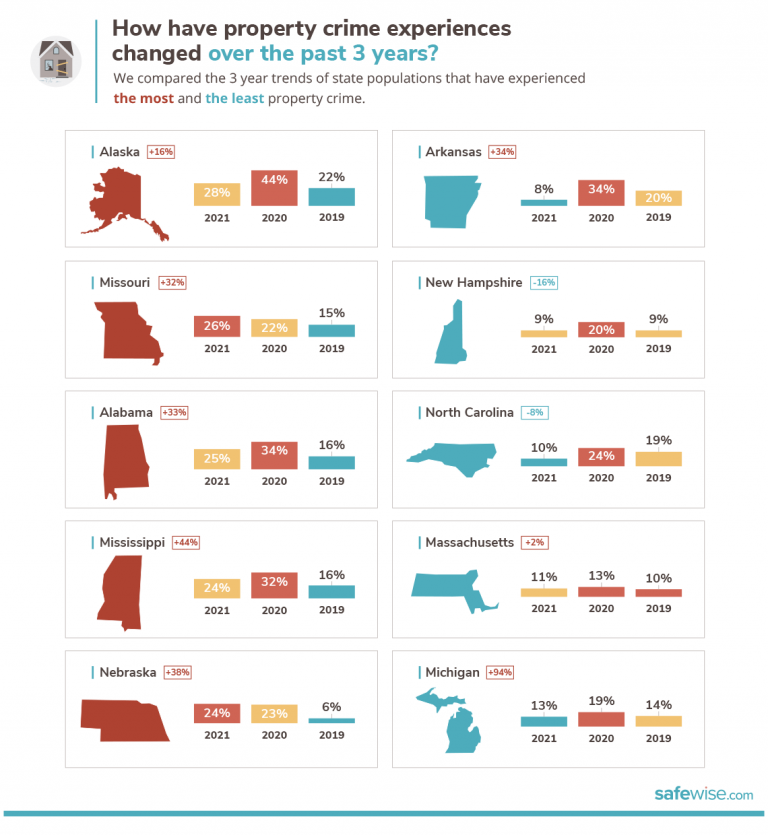
Alaska reported the most experience with property crime in the past 12 months. Firearms are the most-used property protection in Alaska, followed by guard animals.
Arkansas reported the least experience with property crime in the past 12 months. Guard animals are the most-used property protection in Arkansas, followed by firearms.
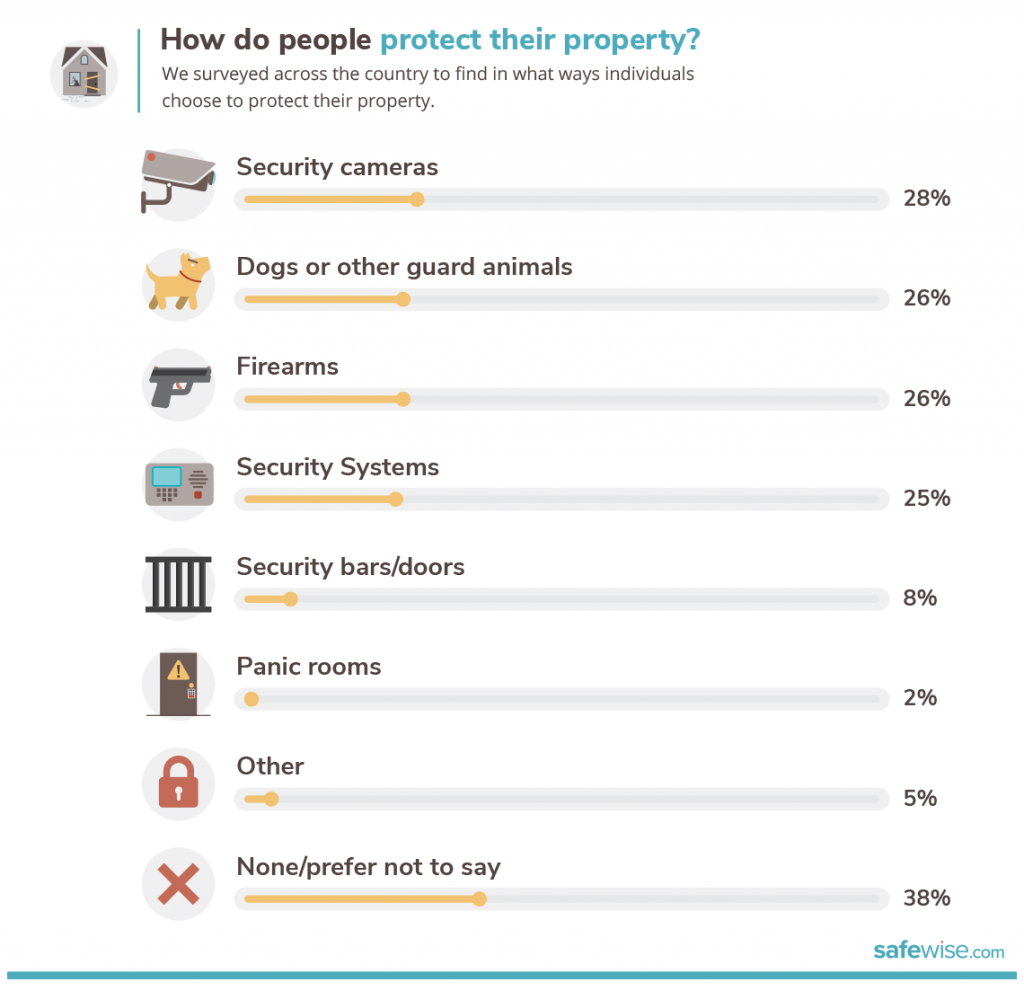
Interesting findings
- Security cameras and security systems are the only security measures that are growing in popularity, with both guard animals and firearms seeing a drop year over year.
- Although general concern rose minimally year over year (2%) and most Americans think crime is on the rise, use of property protection measures dropped by 6% this year.
- More states (both high and low experience) saw reported experience with property crime increase between 2019 and 2021 (9 of the 12 listed—75%).
What safety concerns keep Americans up at night?
Property crime in Texas rose 2% year over year and burglaries make up 16% of all property crime in the state.
A closer look at sleep-stealing worries
We asked Americans to tell us what specific worries keep them up at night. Here are some of the takeaways:
- Property crimes (especially break-ins) continue to be the most worrisome overall.
- People are more worried about car theft and break-ins this year—a crime that saw increases in many areas during pandemic lockdowns.
- Digital security (identity theft, hacking, and data privacy) continues to be top of mind for many Americans.
- More people are concerned about things that may lead to crime this year—unemployment, drugs, homelessness, job and housing insecurity, and civil unrest were mentioned often.
- Natural disasters and extreme weather came up more often this year, especially wildfires and flooding.
- Perceived neighborhood safety (or lack thereof) is a strong trend that impacts higher levels of concern or a complete lack of concern.
New Mexico worries less than most of America, but it's tied with Louisiana for the state where people feel the least safe overall.
Does worry lead to taking action?
Even though Americans continue to think crime is on the rise, that isn’t enough to increase security measures.
- Only 1 in 5 Americans has increased security measures in the past year.
- 1 in 3 Americans uses some method of personal protection like pepper spray.
- Overall, insurance is by far the most widely used form of protection that Americans use, with only 14% saying they use none.
- 38% of Americans don’t do anything to provide extra security to their property.
Download the full national report by hitting the button below. To request a copy of your state's report email rebecca@safewise.com.
How much do people worry about crime in your state?
Find the safest cities in each state
- Alaska
- Alabama
- Arkansas
- Arizona
- California
- Colorado
- Connecticut
- Delaware
- Florida
- Georgia
- Hawaii
- Iowa
- Idaho
- Illinois
- Indiana
- Kansas
- Kentucky
- Louisiana
- Massachusetts
- Maryland
- Maine
- Michigan
- Minnesota
- Missouri
- Mississippi
- Montana
- North Carolina
- North Dakota
- Nebraska
- New Hampshire
- New Jersey
- New Mexico
- Nevada
- New York
- Ohio
- Oklahoma
- Oregon
- Pennsylvania
- Rhode Island
- South Carolina
- South Dakota
- Tennessee
- Texas
- Utah
- Virginia
- Vermont
- Washington
- Wisconsin
- West Virginia
- Wyoming
Related articles on SafeWise
Endnotes
Gun violence
SafeWise uses data from the Gun Violence Archive (GVA) to track gun violence incidents. We also adhere to the GVA definitions for mass shootings and officer-involved incidents.
- Mass shooting definition: “If four or more people are shot or killed in a single incident, not involving the shooter, that incident is categorized as a mass shooting based purely on that numerical threshold.”
- Officer-involved incidents: Safewise combined multiple GVA reports to determine the total number of officer-involved incidents per year. The numbers in our report represent the total number of officers injured, officers killed, subjects injured, and subjects killed in the identified year.
All GVA data is current as of the date last accessed. The GVA regularly changes and updates its data as incidents are examined for accuracy.
Package theft
Although package theft, if represented at all, is included in the FBI UCR data among larceny-theft incidents, SafeWise recognizes it as a subcategory that is growing across the country. We have adopted the definition of package theft as identified in a recent American Journal of Criminal Justice study.
- Package theft definition: “Taking possession of a package or its contents, outside of a residence or business, where it has been commercially delivered or has been left for commercial pick-up, with intent to deprive the rightful owner of the contents.”
Sources
FBI: Uniform Crime Reporting Program, “2019 Crime in the United States,” Accessed March 15, 2021.
Gun Violence Archive, “Past Summary Ledgers,” Accessed January 6, 2021.
Gun Violence Archive, “General Methodology,” Accessed March 15, 2021.
Melody Hicks, Ben Stickle, Joshua Harms, American Journal of Criminal Justice, “Assessing the Fear of Package Theft,” January 04, 2021. Accessed March 15, 2021.
For more definitions and data sources, see our methodology page.
The post The State of Safety in America 2021 appeared first on SafeWise.
Article source here: The State of Safety in America 2021

